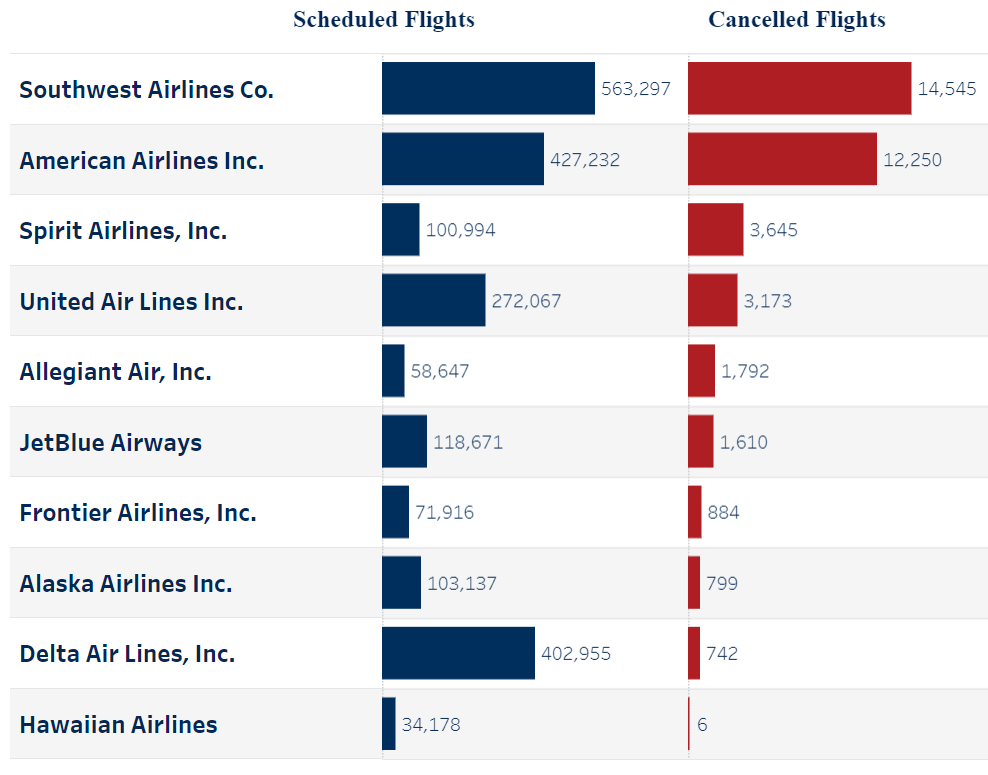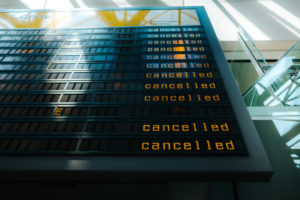Worried about your holiday travel plans this year after reading about recent mass flight cancelations from American Airlines and Southwest? You have reason to be. If you want to increase the odds of getting to your destination this holiday season, you’ll need to pick the right airline. We’ve crunched data from FlightAware to give you the best information available for traveling this holiday season.
Related: The Best Tools for Flexible Date Searches
Why Are Flights Getting Canceled This Year?
Airlines began having trouble with cancelations in the summer travel season when passengers returned to the skies in larger numbers than expected. This increased demand meant that airlines wouldn’t have enough staff for flights they already sold. When pilots and flight crew max out their flight hours allowed by the Federal Aviation Administration (FAA), airlines have no option but to cancel flights.
When American Airlines made headlines for their thousands of flight cancelations this summer, they blamed delays on poor weather systems near their hub in Dallas, as well as operational and staffing challenges.
Yet, as recently as the weekend of November 1, American canceled another 2,000 flights, in large part because of scheduling issues with pilots and flight crew.
“They couldn’t find a way to connect the pilots and the flight attendants to the airplane,” said AlliedPilots Association Spokesman Capt Dennis Tajer in an interview with Fox News.
“It’s a structural scheduling problem that management has gotten themselves into,” he explains, “The pilots are ready to fly; you’ve got to be able to connect us to the airplane.”
Part of the problem is the reduced workforce. During the pandemic, around 1,000 pilots took an early retirement buyout offer from American. Now that travel has returned to pre-pandemic levels, American can’t hire and train new pilots fast enough to meet demand.
It’s not just a lack of pilots. American’s flight crew is also understaffed. Internal reports reviewed by the Associated Press revealed that two-thirds of the cancelations made on Halloween weekend were from a lack of flight attendants.
Notably, American Airlines is still in negotiations with the pilots’ union for pay. American offered a 50% bonus for flying peak times and double pay for working holidays. The pilots’ union rejected it, citing concerns with American’s scheduling. They believe this issue is the reason for the airline’s mass cancelations and money alone won’t fix the problem.
In other words, American Airlines may not have resolved their issues causing flight cancelations. They may be forced to cancel flights throughout the holiday season.
Southwest, Spirit, and Allegiant owe their cancelations in large part to staffing shortages as well, but in a different way. These airlines operate a point-to-point model rather than a hub-and-spoke model. This means they have more direct flights. However, when weather issues or staffing shortages affect one location, it leaves crew and planes out of position for the next location. With a smaller staff left this year to cover when things go wrong, it leads to a cascading failure.
Related: Strategies to Get a Refund on Nonrefundable Airfare
Choose Your Airline Wisely
Knowing what airlines are most likely to cancel their flights can help you decide which carrier to fly around the holidays.
From June 1 to November 15, Spirit Airlines was the airline with the greatest percentage of cancelations at 3.6%. American, Allegiant, and Southwest all had cancelation rates around 3%. Yet, these numbers don’t tell the whole story. When you look at holiday and weekend travel, cancelation rates on some airlines have exceeded 30%.

Related: How Early Should I Arrive at the Airport for an International Flight?
The Worst Airlines for canceled Flights
According to FlightAware, these were the airlines with the most canceled flights in the U.S. from June 1 to November 15, 2021.

Some airlines are doing significantly better than others when it comes to cancelations.
Hawaiian Airlines has only canceled six of their 33,000 scheduled flights since June 1. This equates to a one-hundredth of a percent cancelation rate (.017%).
Delta also has an extremely low cancelation rate, which is all the more impressive given that it operated more than 400,000 flights from June 1 to November 15. Only 742 flights were canceled, representing a .18% (about two-tenths of a percent) cancelation rate. This is far below the 1% overall cancelation rate in pre-pandemic travel.
Other carriers, such as United, Frontier, Jetblue, and Alaska are all on par with pre-pandemic cancelation numbers at 1%. The odds of your flight being canceled with one of these carriers is about the same as it was in pre-pandemic travel.
| Airline | Flights Scheduled | Canceled Flights | Cancel Percentage |
| Spirit Airlines | 100,994 | 3,645 | 3.6% |
| Allegiant Air | 58,647 | 1,792 | 3% |
| American Airlines | 427,232 | 12,250 | 2.9% |
| Southwest Airlines | 563,297 | 14,545 | 2.6% |
| Jetblue Airways | 118,671 | 1,610 | 1.35% |
| Frontier Airlines | 71,916 | 884 | 1.2% |
| United Air Lines | 272,067 | 3,173 | 1% |
| Alaska Airlines | 103,137 | 799 | .77% |
| Delta Air Lines | 402,955 | 742 | .18% |
| Hawaiian Airlines | 33,974 | 6 | .017% |
Your Best Bet to Avoid a Canceled Flight
If you want to avoid a canceled flight, you should choose your airline wisely. You now know what airlines are most likely to cancel your flight. Based on past data, flying American Airlines, Southwest, Spirit, and Allegiant this holiday season is going to be a gamble. Flying Delta, Hawaiian, United, Alaska, Frontier, or JetBlue gives you a much better chance of reaching your destination without any issues.






